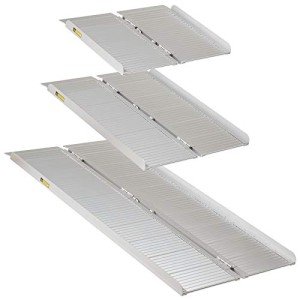The Biggest Problem With Portable Ramp For Wheelchair And How To Fix It

The Importance of Portable Ramps for Wheelchairs: Enhancing Mobility and Accessibility
In a world that prides itself on inclusivity, guaranteeing that individuals with mobility challenges can browse their surroundings freely remains a vital concern. One of the most effective solutions for enhancing mobility is making use of portable ramps for wheelchairs. These ramps supply a vital ways of conquering barriers, whether at home, work, or in public areas. This post will check out the significance of portable wheelchair ramps, their numerous types, essential features to think about, and frequently asked concerns about their usage.
The Need for Portable Ramps
Wheelchair users typically come across physical challenges that make browsing the environment challenging. From curbs to steps, the lack of accessibility can restrict independence and lead to increased disappointment. Portable ramps act as a practical service to these barriers, making it possible for smoother transitions between different surfaces.
Advantages of Portable Ramps
The advantages of portable wheelchair ramps extend beyond easy mobility support. Below are a few key advantages:
-
Enhanced Independence: Portable ramps empower Mobile Wheelchair Ramp users by enabling them to access homes, cars, and public places without needing support.
-
Adaptability: They can be used in various settings, from domestic homes to parks, making them a valuable addition for anyone with mobility difficulties.
-
Alleviate of Transportation: Many portable ramps are created to be lightweight and retractable, making them easy to transportation.
-
Affordability: Compared to more irreversible installation services, portable ramps typically represent a portion of the cost while supplying sufficient accessibility.
Types of Portable Ramps
When selecting a portable ramp, comprehending the various types readily available is vital. The following table sums up the most common types of portable ramps for wheelchairs:
| Type | Description | Best For |
|---|---|---|
| Folding Ramps | Ramps that can be folded in half for simple transportation. | Vehicles, entrances, and steps. |
| Telescoping Ramps | Ramps that can extend and withdraw for varying heights. | Trucks, SUVs, and unequal surface areas. |
| Modular Ramps | Customizable systems that can be put together as required. | Permanent or semi-permanent setups. |
| Limit Ramps | Developed to bridge little height distinctions, like doorways. | Homes and smaller entranceways. |
| Roll-up Ramps | Lightweight ramps that can roll up for portability. | Quick shifts on the go. |
Key Features to Consider
When picking a portable ramp, numerous functions must be taken into account to ensure it satisfies the user’s needs. Below is a list of necessary functions:
-
Weight Capacity: Ensure the ramp can support the user’s weight and any extra devices, like oxygen tanks or other mobility help.
-
Length and Angle: The length of the ramp affects its slope. A longer ramp supplies a gentler incline, which is easier to navigate.
-
Product: Portable ramps are commonly made from aluminum, plastic, or wood. Aluminum is lightweight and durable, while plastic typically provides some weight decrease and is resistant to weather.
-
Surface area Texture: A non-slip surface helps guarantee safety during usage, particularly in wet weather.
-
Portable Design: Look for ramps that are easy to fold, roll, or transport without unique tools.
-
Security Features: Some ramps include built-in side rails or security straps to secure them in place, enhancing user safety.
-
Personalization: Consider ramps that can be tailored in length, width, or slope to suit private requirements.
Often Asked Questions (FAQ)
1. How do I identify the ideal length of a portable ramp?
To figure out the proper length of a portable ramp, the general standard is the slope ratio. Preferably, for every single inch of height, there must be at least 12 inches (1:12 ratio) of ramp length. For instance, if an action is 6 inches high, the ramp needs to be at least 6 feet long.
2. Can portable ramps be utilized for vehicles?
Yes, portable ramps are particularly developed for loading wheelchairs into cars, consisting of cars, vans, and SUVs. Make certain to choose a ramp that is appropriate for vehicle usage and can handle the weight of the wheelchair and user.
3. What maintenance do portable ramps require?
Upkeep is reasonably uncomplicated. Regularly inspect the Wheel Chair Ramp for indications of wear and tear, such as fractures or bent areas. Tidy the surface area to eliminate dirt or debris that could impact traction, and inspect the hinges or retractable parts for any functional problems.
4. Exist portable ramps suitable for outdoor usage?
Yes, many portable ramps are created for outside usage and constructed from weather-resistant products. It’s important to choose a ramp that can endure different weather conditions to preserve toughness and security.
5. How much do portable ramps usually cost?
The rate of portable ramps differs widely based on size, materials, and features. On average, prices can vary from ₤ 100 to ₤ 600. Higher quality and specialized Metal Ramps For Wheelchairs might cost more but provide higher durability and safety.
Portable ramps for wheelchairs are indispensable tools that promote mobility and ease of access for individuals with disabilities. The advantages they offer, from improving independence to decreasing barriers, highlight their importance in daily life. When choosing a portable ramp, users need to consider numerous types, crucial features, and personal requirements to discover the finest fit for their needs.
As society continues to evolve towards higher inclusivity, investing in portable ramps allows everybody the opportunity to browse their world more freely and with confidence.

